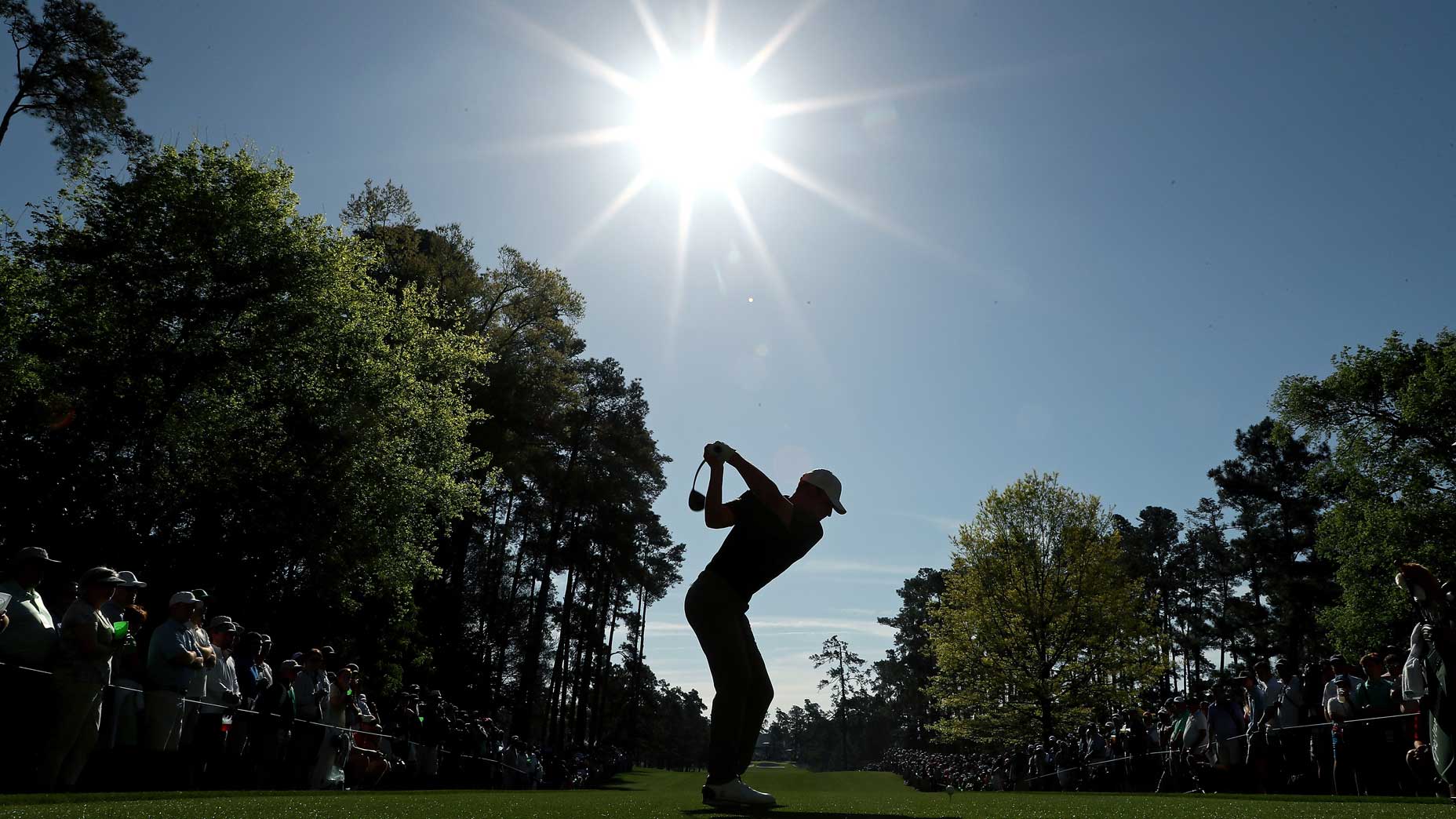From Seminole to Pine Valley: Inside golf’s competitive, exclusive mid-am circuit

Then-firefighter Matt Parziale (pictured) won the U.S. Mid-Am and punched his ticket to the 2018 Masters.
Getty Images
On a mid-September day at the greatest golf course in the world, Andrew Price finished off his opponent on the 17th green — and there was virtually nobody there to see it.
With his 2-and-1 victory, Price became the champion of the 99th Crump Cup, an event that represents, in some ways, the pinnacle of country-club golf, held at the vaunted, uber-exclusive Pine Valley Golf Club in Clementon, N.J. Because it’s the best club players competing at the best club, the Crump is often considered the crown jewel of golf’s most old-school competitive tour: the mysterious, prestigious mid-am circuit.
What makes a mid-am? In 1981, the USGA established the U.S. Mid-Am — restricted to low-handicappers at least 25 years old — as one of its national championships. Their reasoning was pretty simple: Competitive juniors or college players, whose days center around full-time golf practice, were beginning to dominate competitions reserved for amateurs. The establishment of the Mid-Am effectively codified the importance of a prestigious competition for a particular subset of golfer: someone whose school-age days are behind them but wasn’t chasing a career as a professional. When you take out top college kids and all pros, who’s left? The very best golfers who aren’t doing this full time.
In many ways the existence of the Mid-Am harkens back to golf’s most famous amateur golfer and the golf ethos he represented. Bobby Jones won golf’s Grand Slam but never turned professional, preferring instead the stability of his job as a lawyer in Atlanta, which allowed him a predictable schedule and plenty of time with his family. And, as the son of a well-to-do family, Jones was also exempt from the financial challenges of others more fully devoted to the sport. Unlike those touring to compete in exhibitions for cash, Jones was a gentleman golfer.
You’ve likely heard about the money in professional golf in the century since: It’s gone up. By a lot. The stigma around professional golfers as something less than gentlemen has long since disappeared. But competitive amateurs remain; there are more of them than ever. You know them. You play with them. You may well be one of them. In a nod to their importance, the winner of the U.S. Mid-Am receives an invitation every year to the world’s greatest club tournament, the one Jones helped found: the Masters at Augusta National.
If the Crump Cup is the mid-am equivalent of the Masters — prestigious, exclusive host course, air of secrecy — then then U.S. Mid-Am is its U.S. Open. Run by the USGA, it’s the national championship for those 25 and up; unlike the invite-only Crump Cup, it’s open to anybody with a handicap of 2.4 or better.
But those two tournaments are just the tip of the iceberg. Or perhaps the ice cube; this set of tournaments has earned its moniker as the “cocktail circuit” for a reason.
A high-profile mid-am might start his year at the “Coleman,” the shorthand version of the George L. Coleman Invitational, held inside the well-protected gates of exclusive Seminole Golf Club in Florida. In 2024 Evan Beck, who would later win the U.S. Mid-Am, finished three shots ahead of Northern Ireland’s Matthew McClean, the world’s top-ranked mid-am. Scott Harvey, a past champ not just at the Coleman but the Mid-Am, too, finished third. Bobby Wyatt, an Alabama grad who played a couple years on the PGA Tour, finished fourth. You get the idea: there’s plenty of talent at these things.
A talented mid-am could in fact play a schedule based entirely around tournaments at prestigious clubs in tournaments that include a man’s middle initial: not just the George L. Coleman but the George C. Thomas Invitational at L.A. Country Club, the Walter J. Travis Invitational at Garden City Golf Club just outside New York City, the John T. Lupton at the Honors Course in Ooltewah, Tenn., the John G. Anderson Memorial at Winged Foot.
In fact, the mid-am circuit likely visits more well-regarded courses than the PGA Tour itself; these clubs appreciate the understated nature of the mid-am scene rather than the full-on takeover that comes with hosting a professional event — including the logistics that come with [gasp] large groups of fans. Even the Crump, which used to allow fans in once a year for its final round, has suspended that policy in recent years. Profit maximization has never been the focus here.
There are other all-ages amateur events that feature mid-ams, too: the U.S. Am, which visits a rotating cast of prestigious sites, the North and South Am, held at Pinehurst, the USGA Four-Ball, which has visited the Philly Cricket Club, Kiawah Island and Chambers Bay in recent years, the Azalea Invitational at the Country Club of Charleston and so on. The Walker Cup is on a particularly absurd run of elite golf, pinging from Royal Liverpool to Seminole to the Old Course to, next year, Cypress Point. That match-play showdown includes at least one mid-am on each side, making it another event that blends the best ams of all ages.
But the existence of separate mid-am-only events separates those 25 and up from competitive junior players the same way your club might ban college golfers from its club championship, restricting the competition and the cocktail party to men of a certain age.
So who are these guys? Depending on your vintage, some have names you may recognize. Remember Trip Kuehne? In 1994, the first of three years that he was an All-American at Oklahoma State, Kuehne took a six-up lead over Tiger Woods in the final of the U.S. Amateur. Woods staged a furious comeback and dispatched him, adding to his junior legend, but Kuehne’s runner-up status still earned him a berth into the Masters and he qualified for the 1996 U.S. Open through qualifying, too. But Kuehne opted not to turn pro, entering the world of finance instead. It’s tough to argue with his success in that field, as he ultimately founded a hedge fund, Double Eagle Capital, in 2005. But he didn’t leave golf behind: In 2007 he won the Mid-Am at Bandon Dunes, establishing himself as one of the world’s best non-pros — and earning a return trip to the Masters.
“I like to start at the Coleman in April and end with the [U.S.] Mid-Amateur in October,” he said in one decades-old interview about the mid-am circuit. Kuehne is senior-circuit eligible now — he played in the U.S. Senior Open this summer — but that sentiment remains: It’s not a bad way to spend the summer.
This generation’s highest-profile mid-am is likely Stewart Hagestad; the 33-year-old California native played college golf at USC and first made waves when he won the 2016 Mid-Am and made the cut at the 2017 Masters, where he finished as Low Am but made it clear that he had no intention of turning pro. He won the Mid-Am again in 2021 and again in 2023, putting him on a short list of all-time champs. Hagestad has also represented the United States on four consecutive Walker Cup teams, all of them winners. When he’s not on the golf course? He works for a bank.
Playing a big-time mid-am circuit requires some financial stability and vocational flexibility — mid-week tournaments, extended stays in expensive locations — but not every successful mid-am comes from the same background. The fields include underdog stories of double-duty heroes, like Matt Parziale, the then-firefighter who won the 2017 Mid-Am. His win showcased the beauty of these mid-am competitions: a chance at glory for the working man.
And there are new faces and new perspectives entering the mid-am mix. Hagestad may not even be the most famous mid-am golfer — depending how you define it, that title could belong to YouTuber Grant Horvat, who is part of a wave of talented players eschewing the grind of full-time stroke-play competition for the comparatively balanced lifestyle of content, entertainment and competition. You could also point to Tony Romo, retired NFL quarterback, as the avatar for the hungry mid-am. Some former pros have gotten their status back, too — a constant point of tension in mid-am circles — but one thing remains true: Every golfer, at every age, of every background, no matter their success in other arenas, is obsessed with better. Entries in the U.S. Mid-Am have demonstrated the covid-era golf boom: A new record of 5,708 in 2022 was surpassed by a new record of 6,060 in 2023, a number that was effectively matched in 2024. Mid-Am golf? It’s cooler than ever.
Somewhere in the middle of this old-school-meets-new-school clash is the Bridges Cup, a three-year-old competition run by 8AM Golf, GOLF’s parent company, which is seeking to become the world’s premier mid-am match-play competition. The Bridges Cup features a Ryder-Cup style showdown between Team USA and the International Team, each comprised of elite ams hand-picked by the tournament committee.
As is the case with these elite fields, competitors have played in majors and won prestigious amateur events; their reward is a trip to an international destination for an immersive team experience. After last year’s event took place at expansive golf oasis Les Bordes in France, this year it returns to Haesley Nine Bridges in South Korea. The event comes on the heels of the U.S. Mid-Am and the Crump. It comes a few months before the Azalea and the Coleman will kick off the 2025 golfing year.
Pretty good way to finish up your golf season. If you can swing it.
Related
5 Things I Never Play Golf Without: David Dusek
Our 11-handicap equipment writer always brings his favorite divot repair tool, a portable speaker and some high-tech gear to the course.As long as the weather i
Donald Trump’s golf course wrecked by pro-Palestine protesters
Pro-Palestinian protesters have vandalized parts of U.S. President Donald Trump's golf course in Scotland in response to his proposal for the reconstruction of
Man holding Palestinian flag scales London’s Big Ben hours after…
CNN — Emergency services were called to London’s Palace of Westminster on Saturday a
EPD: Drunk driver parked car on golf course
EVANSVILLE, Ind. (WFIE) - Evansville police say they arrested a man after finding him drunk in his car that was parked on a golf course.Officers say they were c












